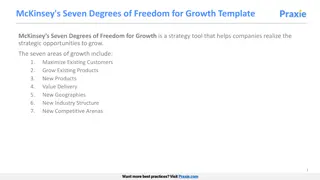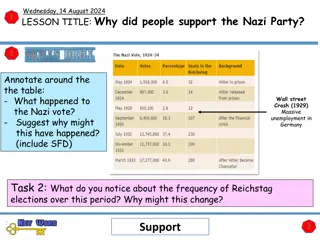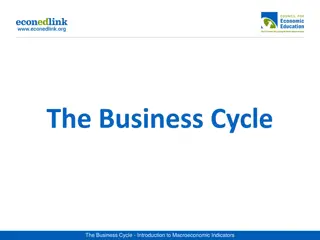The Rise of eSports: From Basements to Arenas
eSports has evolved from casual gaming in basements to professional competitive gaming events with lucrative revenues. With the cancellation of live events during the COVID-19 outbreak, online play has become crucial for attracting fans. Platforms like Twitch have become central to eSports, offering opportunities for streamers to engage with viewers and receive support. Team sponsorships, media rights, and franchising are key revenue sources, with players earning significant prize money, such as Kyle Giersdorf who won $3 million in the Fortnite World Cup.
Download Presentation

Please find below an Image/Link to download the presentation.
The content on the website is provided AS IS for your information and personal use only. It may not be sold, licensed, or shared on other websites without obtaining consent from the author. Download presentation by click this link. If you encounter any issues during the download, it is possible that the publisher has removed the file from their server.
E N D
Presentation Transcript
From Basements to Arenas in a Flash In retrospect, eSports was inevitable. Teens and young adults played video games in their basements and competed with others; some players developed exceptional skills; and team formation followed, with events, sponsorships, marketing and an online presence. Newzoo, a major leader in games market insights and analytics, defines eSports as professional-level competitive gaming in an organized format (tournament or league) with a specific goal/prize, such as winning a championship title or prize money. Together, video games and eSports 2018 US revenues were $24.4 billion, and are forecast to increase to $31.1 billion by 2023. The global eSports market was expected to exceed $1 billion for 2019, a 26.7% increase, with $409.1 million just from North America.
Effective Targeting of Young Men During the COVID-19 outbreak, eSports live events, like those of all traditional sports, have been cancelled. Play continues online, however, providing eSports with a major advantage over traditional sports not only to generate revenues, but also attract other sports fans. Based on NewZoo s definitions, the 2019 forecast of the total global eSports audience was 454 million, a 15% YOY increase, or 253 million occasional viewers and 201 million enthusiasts. By 2022, the total global audience is projected to increase to 645 million. Unsurprisingly, the vast majority of eSports fans are young men, or approximately 70%, although a 2018 Nielsen study estimated 83% of US eSports fans were men and most male players (44%) want to learn tips and tricks from professionals.
Twitch Is the Doorway to eSports Twitch was initially created to be a general-interest streaming platform, but then became the place where video game players congregated. Once again, Amazon proved its foresight by acquiring the platform during 2014, and it has expanded since. Twitch consists of a number of streamer channels, which promote donations from visitors as a method to support streamers. Some visitors will actually donate enough to motivate a streamer to engage with them, and even play a game or watch the streamer play. Visitors can also subscribe to streamers channels for a base price of $4.99, which provides access to a chat channel with other visitors/subscribers. Most streamers receive half of the subscription fee, although those with larger numbers of subscribers can receive more.
Multiple Sources for Generating Big Bucks According to PwC research and analysis, team sponsorships generate the most revenue for eSports, and are forecasted to reach $598 million by 2023, a CAGR (compounded annual growth rate) of 16.3%. Sponsorships may generate the most revenue, but PwC estimates revenues from media rights will increase faster, with a CAGR from 2018 to 2023 of 25.0%, or $506 million. Franchising is another revenue generator and betting on eSports is likely to increase too. For professional eSports players, including those who are still teens, millions are on the table. Kyle Giersdorf, a 16-year-old Pennsylvania resident, won $3 million during the first Fortnite World Cup, July 2019.
Women Like eSports, Too Although almost half of all persons who play casual and mobile games are women, just 17% of those in the US described themselves as eSports fans, according to 2018 Nielsen data. Women in Games, however, estimates just 5% of women have a role in eSports, although 81% say they have had positive experiences. Nonetheless, another study found 62% of women don t think eSports brands are targeting them. Research from Momentum Worldwide revealed 81% of women who are attracted to BlizzCon, TwitchCan, the Overwatch League Grand Finals and other eSports events will fly to an event and 60% will spend $125 for merchandise and branded premiums.
Marching into the Mainstream With its audience participation and excitement, eSports was almost created for TV and other visual media. Sports broadcast channels are airing tournaments and many major brands are sponsors or advertisers, all in the race to reach teens and young adults. eSports lounges are opening in many locations, with PLAYlive Nation operating 96 locations in 17 states. The lounge concept could be a significant opportunity for shopping malls and other retailers to add to their increasing number of leisure-activity attractions. Major and specialty institutions of higher education are also adding eSports facilities to their campuses. Some, like The Ohio State University, now offer undergraduate and graduate degrees in eSports content production.
Advertising Strategies Although eSports events are closed due to the pandemic, promoters and other businesses in the eSports industry have a unique opportunity to use local TV to benefit from the very large increases in young adult viewership. Invite a local college student who is studying broadcast journalism and is an eSports fan, and even an amateur player, to serve as a part-time special correspondent to report on eSports events and other news for the station s Website and social media. A local eSports lounge or arena or a group of eSports businesses can gain some community goodwill by providing first responders, hospital personnel and others on the frontline of the pandemic fight a free video game, including those favored by eSports fans.
New Media Strategies Although many eSports lounges are closed like restaurants and bars, use short videos posted to social media to announce the reopening schedule and explain new safety policies because of the pandemic. Offer free face masks at the door. According to research, many female fans of eSports fly to events and index higher as international travelers. Lounges and other eSports businesses can use this affinity to share new travel packages from the hospitality industry on Websites and social media posts. Create a series of short videos to educate parents, teachers and other adults about eSports in an attempt to minimize any negative perceptions and to promote it as a good activity for brain development and social bonding.

















































